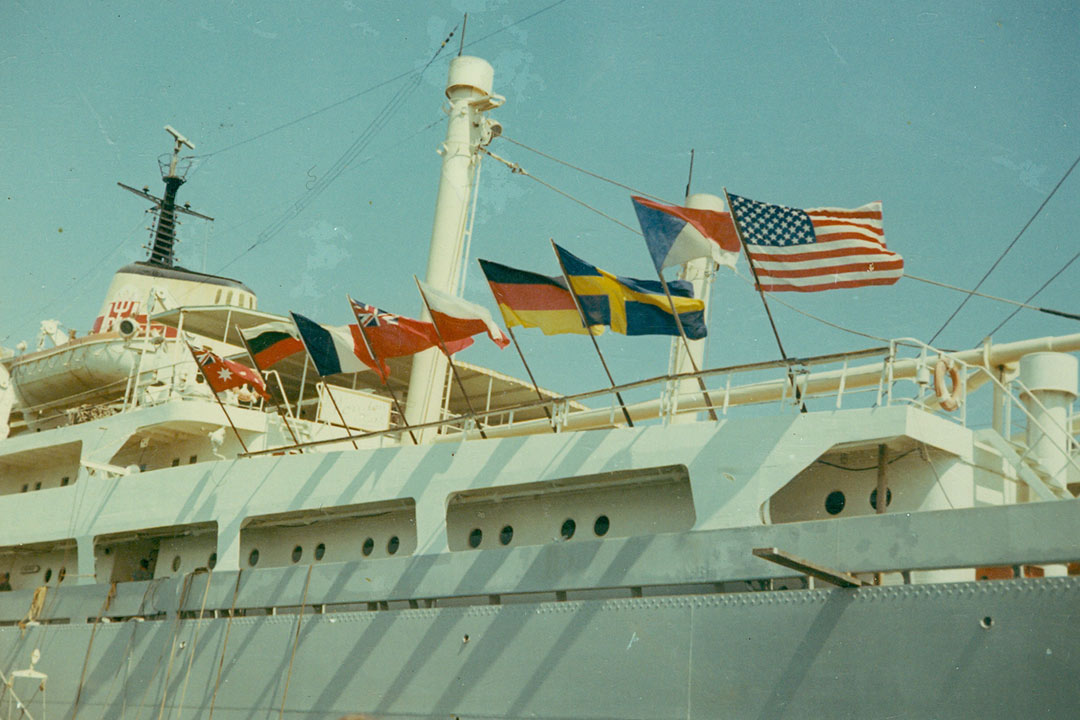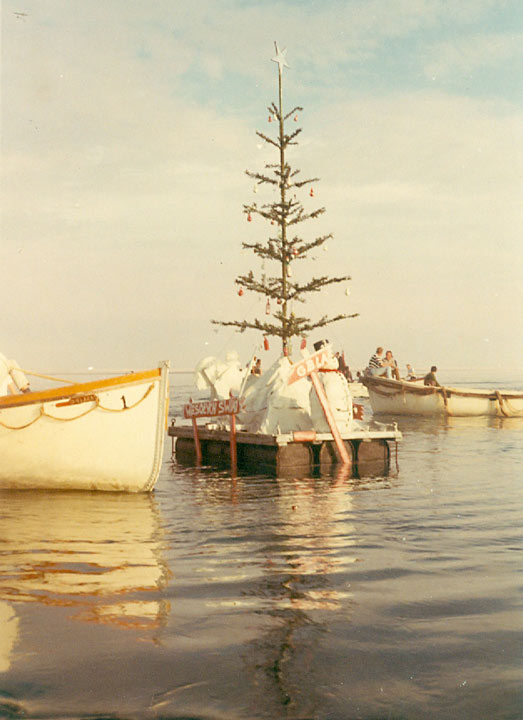A Wesołych Świąt stranded in the Suez Canal
Christmas on a ship, somewhere hot and sunny, with not a lot to do. Sounds idyllic doesn’t it? This wasn't necessarily the case for an international group of seafarers who were stranded in the Suez Canal for several Christmases following the Six Day War. However, they found festive spirit and companionship in this unusual setting, despite the odds.

Christmas in the Suez Canal. Photograph courtesy of Jack Spencer.
Let’s be honest, after weeks of Christmas preparations (which can make the holiday seem like an awful lot of work) who hasn’t nurtured a secret desire to do it all differently one year and sail off in to the sun? The Suez Canal however is perhaps not the first place that springs to mind as a Christmas getaway.
The Canal is a manmade waterway built in Egypt in the 19th century, an important trade route linking the Mediterranean and Red Seas. In June 1967 years of political tension between Egypt and Israel erupted in what would become known as the Six Day War. Faced with Israeli occupation of the east bank of the Canal, Egypt blocked both ends. Passenger ships in the canal had been allowed to leave but orders were for the cargo vessels to stay put. This left a group of 14 ships stranded in the Great Bitter Lake area of the canal, where they would remain, trapped by obstacles both physical and political, for a further eight years.
The stranded ships were from eight different nationalities and represented countries from both sides of the iron curtain during what was the height of the Cold War, but they quickly formed a community. People with different languages and cultures, stuck in the same unusual situation, came together for mutual support and recreation. They formed a society known as the Great Bitter Lake Association (GBLA) and together the crews put on film nights, football competitions, and even held their own version of the Olympic Games in 1968.

Flags from the different nations in the GBLA. Photograph courtesy of George Wharton.
The ships all participated in the GBLA, pooling their resources and helping each other to find fun in their strange position. The French ship, Sindh, was known for its fine cuisine and dinner invitations there were highly sought after amongst the other ships. The Swedish Nippon had an on board gym. West German ship, Münsterland, had cool stores filled with Australian grapes, which they supplied to the Bulgarian Vassil Levsky, where the crew used them to make an apparently excellent brandy. Polish ship, Djakarta, always had a doctor on board throughout the eight years and they provided essential free healthcare to the GBLA community. This group of international seafarers joked that they had formed a United Nations rather more successful than the real thing. Captain Brian McManus, of the Liverpool based Blue Funnel Line ships Agapenor and Melampus, suggested this was partly due to the nature of seafaring and those drawn to a life at sea.
“The one thing in common that seafarers of all nations possess is their ability to get along with most other people. It is a necessity of sea life where men of different upbringing, sometimes colour, certainly very often creed, live and work together. One thing which is greater among seafarers than people ashore, is companionship.”

Christmas tree created by Polish seafarers from the Djakarta. Photograph courtesy of George Wharton.
Probably the best illustration of this sense of companionship and community is the first Christmas the ships spent together. In October 1967 arrangements had finally been made to exchange the original stranded crews for fresh ones. This new batch of seafarers knew what they were heading into and had come prepared to make the best of it. For example Liverpool’s Blue Funnel Line had two ships in the Canal and sent the relief crews out armed with Christmas hats, decorations, and turkeys. Polish seafarers from the Djakarta built the floating Christmas tree you can see in the picture above, it was more than 4m high and had even been rigged with lights! In the front you can see the letters GBLA for Great Bitter Lake Association and to the left a sign saying “Wesołych Świąt”, Polish for Merry Christmas. A group from British ship, Port Invercargill, somehow manoeuvred their piano into a lifeboat and set off round the lake serenading the other crews. On Christmas Eve the crews of all the ships gathered in lifeboats and other small vessels around the floating Christmas tree. British seafarer, George Wharton, who took the photograph above, remembers:
“There we were in the desert, with the stars in the sky. Each crew sang a carol in their own language. When the German crew sang Silent Night, it was a really emotional moment.”
There are many great anecdotes from the years the ships spent stranded and all of them emphasise a real sense of international friendship and community and the Maritime Museum had the pleasure of seeing some of these friendships renewed at a 50th anniversary reunion a few years ago. Seafarers have for generations taken home stories of the wider world, of different cultures and different ways of life. Hopefully these tales of friendship across political boundaries played their role in helping break down the prejudices of the East/West divide in the 20th century.
From all of us here at the Maritime Museum, Wesołych Świąt!
